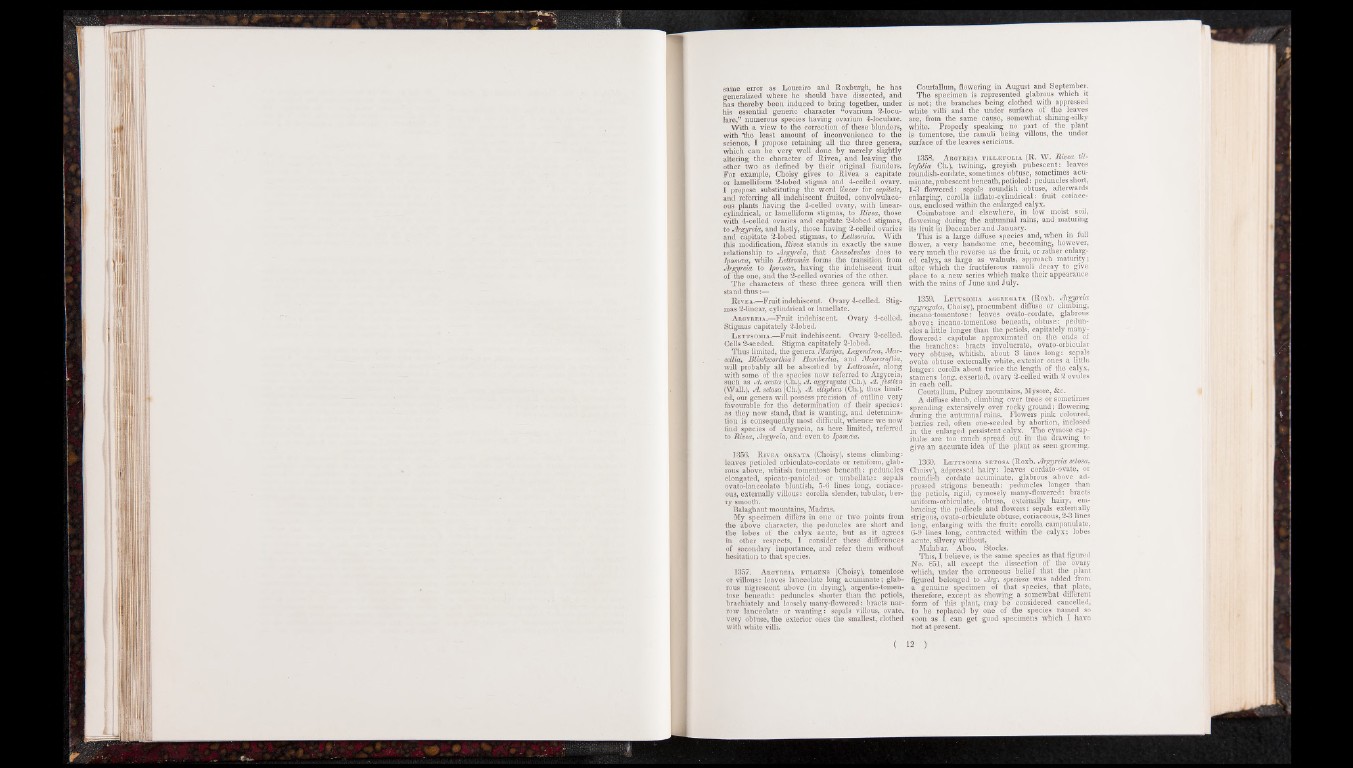
same error as Loureiro and Roxburgh, he has
generalized where he should have dissected, and
has thereby been induced to bring together, under
his essential generic character “ovarium 2-locu-
lare,” numerous species having ovarium 4-loculare.
With a view to the correction of these blunders,
with "the least amount of inconvenience to the
science, I propose retaining all the three genera,
which can be very well done by merely slightly
altering the character of Rivea, and leaving the
other two as defined by their original founders.
For example, Choisy gives to Rivea a capitate
or lamelliform 2-lobed stigma and 4-cellcd ovary.
I propose substituting the word linear for capitate,
and referring all indéhiscent fruited, convolvulace-
ous plants having the 4-celled ovary, with linear-
cylindrical, or lamelliform stigmas, to Rivea, those
with 4-celled ovaries and capitate 2-lobed stigmas,
to Argyreia, and lastly, those having 2-celled ovaries
and capitate 2-lobed stigmas, to Lettsomia. With
this modification, Rivea stands in exactly the same
relationship to Argyreia, that Convolvulus does to
Ipomcea, while Lettsomia forms the transition from
Argyreia to Ipomcea, having the indéhiscent fruit
of the one, and the 2-celled ovaries of the other.
The characters of these three genera will then
stand thus :—•
Rivea..—Fruit indéhiscent. Ovary 4-celled. Stigmas
2-linear, cylindrical or lamellate.
Argyreia.—Fruit indéhiscent. Ovary 4-celled.
Stigmas capitately 2-lobed.
Lettsomia.—Fruit indéhiscent Ovary 2-celled.
Cells 2-seeded. Stigma capitately 2-lobed.
Thus limited, the sener& Maripa, Legendrea, Mar-
cellia, Blinkworthia? Hunibertia, and Moorcrojlia,
will probably all be absorbed by Lettsomia, along
with some ox the species now referred to Argyreia,
such as A. acuta (Ch.), A. aggregata (Ch.), A. festiva
(Wall.), A. setosa (Ch.), A. euiphca (Ch.), thus limited,
our genera will possess precision of outline very
favourable for the determination of their species:
as they now stand, that is wanting, and determination
is consequently most difficult, whence we now
find species of Argyreia, as here limited, referred
to Rivea, Argyreia, and even to Ipomcea.
3356. Rivea orna ta (Choisy), stems climbing:
leaves petioled orbiculato-cordate or reniform, glabrous
above, whitish tomentose beneath: peduncles
elongated, spicato-panicled or umbellate: sepals
ovato-lanceolate bluntish, 5-6 lines long, coriaceous,
externally villous : corolla slender, tubular, berry
smooth.
Balaghaut mountains, Madras.
My specimen differs in one or two points from
the above character, the peduncles are short and
the lobes of the calyx acute, but as it agrees
in other respects, I consider these differences
of secondary importance, and refer them without
hesitation to that species.
1357. Argyreia fulgens (Choisy), tomentose
or villous : leaves lanceolate long acuminate ; glabrous
nigrescent above (in drying), argentio-tomen-
tose beneath: peduncles shorter than the petiols,
brachiately and loosely many-flowered : bracts narrow
lanceolate or wanting : sepals villous, ovate,
very obtuse, the exterior ones the smallest, clothed
with white villi.
Courtallum, flowering in August and September.
The specimen is represented glabrous which it
is not; the branches being clothed with appressed
white villi and the under surface of the leaves
are, from the same cause, somewhat shining-silky
white. Properly speaking no part of the plant
is tomentose, the ramuli being villous, the under
surface of the leaves sericious.
1358. Argyreia till.®folia (R. W. Rivea til-
Icefolia Ch.), twining, greyish pubescent: leaves
roundish-cordate, sometimes obtuse, sometimes acuminate,
pubescent beneath, petioled: peduncles short,
1-3 flowered: sepals roundish obtuse, afterwards
enlarging, corolla inflato-cylindrical: fruit coriaceous,
enclosed within the enlarged calyx.
Coimbatore and elsewhere, in low moist soil,
flowering during the autumnal rains, and maturing
its fruit in December and January.
This is a large diffuse species and, when in full
flower, a very handsome one, becoming, however,
very much the reverse as the fruit, or rather enlarged
calyx, as large as walnuts, approach maturity;
after which the fructiferous ramuli decay to give
place to a new series which make their appearance
with the rains of June and July.
1359. Lettsomia aggregata (Roxb. Argyreia
aggregata, Choisy), procumbent diffuse or climbing,
incano-tomentose: leaves ovato-cordate, glabrous
above; incano-tomentose beneath, obtuse: peduncles
a little longer than the petiols, capitately many-
flowered: capitulae approximated on the ends of
the branches: bracts involucrate, ovato-orbicular
very obtuse, whitish, about 3 lines long: sepals
ovate obtuse externally white, exterior ones a little
longer: corolla about twice the length of the calyx,
stamens long, exserted, ovary 2-celled with 2 ovules
in each cell.
Courtallum, Pulney mountains, Mysore, &c.
A diffuse shrub, climbing over trees or sometimes
spreading extensively over rocky ground; flowering
during the autumnal rains. Flowers pink coloured,
berries red, often one-seeded by abortion, inclosed
in the enlarged persistent calyx. The cymose capita
l* are too much spread out in the drawing to
give an accurate idea of the plant as seen growing.
1360. Lettsomia setosa (Roxb. Argyreia setosa,
Choisy), adpressed hairy: leaves cordato-ovate, or
roundish cordate • acuminate, glabrous above adpressed
strigons beneath: peduncles longer than
the petiols, rigid, cymosely many-flowered: bracts
uniform-orbiculate, obtuse, externally hairy, embracing
the pedicels and flowers: sepals externally
strigous, ovato-orbiculate obtuse, coriaceous, 2-3 lines
long, enlarging with the fruit: corolla campanulate,
6-9 lines long, contracted within the calyx; lobes
acute, silvery without.
Malabar. Aboo. Stocks.
This, I believe, is the same species as that figured
No. 851, all except the dissection of the ovary
which, under the erroneous belief that the plant
figured belonged to Arg. speciosa was added from
a genuine specimen of that species, that plate,
therefore, except as showing a somewhat different
form'of this plant, may be considered cancelled,
to be replaced by one of the species named so
soon as I can get good specimens which I have
not at present.